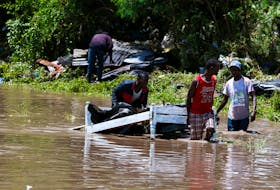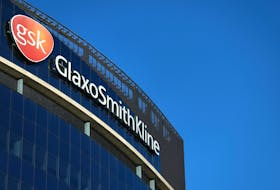Note: This story was originally published in December 2017, to mark the 100th anniversary of the Halifax Explosion.
A defence research scientist says the damage would still be catastrophic for buildings within the historic zone of destruction if the Halifax Explosion were to happen today.
Dr. Darek Baingo, with Defence Research and Development Canada, did an in-depth analysis using computer simulations developed in Canada with his office in Ottawa, DRDC Suffield, Alta., and a company based in Halifax called Martec Ltd., now part of Lloyd's Register's Applied Technology Group.
"The reason that I was asked to do it is because we have an annual disaster risk reduction round table," Baingo said. "Because of the 100th year since (the Explosion), I was asked, ‘Well, let's have a look and see what that would look like for today,' so it was prepared for that purpose, specifically. And it came out a lot more interesting than I imagined."
The Rapid City Planner computational system was developed so disaster management, emergency response and planning departments could model blast events in urban environments, which are vastly different than ones in the open because of the interaction between a detonation and a building's reflection and refraction of blast pressure.
"It's a first-principles, physics-based model so it's not an arbitrary curve-fitting approximation, it's an actual model of the explosion itself, right from detonation, hitting the air, creating the shock waves, (and) how they interact with structures," Baingo said.
"When you are talking something like the Mont-Blanc - three kiloton - it's essentially a tactical nuclear device in terms of yield. It's not nuclear because, of course, it has no radiation but that's how big it is. Considering that Hiroshima was about 20 kilotons, the Halifax bomb was three, so (it was) a very huge explosion. Enormous.
"So with a bomb that size, you actually get the whole spectrum of blast events that you would get in a nuclear explosion."
Heat at the site of ignition reached 5,000 C. The pressure wave destroyed entire neighbourhoods, flattened buildings and damaged others farther away. Fragments of the ship were tossed kilometres.
Even with modern building techniques, the areas closest to the blast would be devastated. For the sake of this story, Dr. Baingo was asked to evaluate the fate of 10 sites in modern-day Halifax and Dartmouth.
Irving Shipyard
"The closest point (to the explosion) is about 125 metres," Baingo said. "That is so close and the pressures are so incredibly high that I would expect complete destruction. I would forget Irving Shipyard. It wouldn't be there. That's enormous, just an enormous blast."
Navy Shipyard
"Even though it's a little farther from the Irving one, it's still within the zone of probable total destruction."
Tufts Cove Power Plant
"That would be bad," Baingo said. "That one is very close. (Typically), 750 metres is not ‘close' but for three kilotons, it is.
"The kind of construction is your typical industrial plant. It's a very light structure, steel with a lot of metal siding, so there's not a lot of mass to counteract, to resist pressure, especially pressure acting over what I calculated lasting over half a second at that point. That's a very long duration of fairly large pressure. It would cause a lot of damage. I couldn't tell you without doing very detailed structural analysis whether it would collapse or how badly, but it would be bad."
Even so, Baingo said the big smokestacks might not be damaged at all because of their circular shape.
Defence Research Development Canada, Dartmouth campus
"That one is actually closer than the power plant so it would definitely be a bad scene there," he said. "Some of those buildings are again, steel-sheet siding, very light, some of it I see is masonry siding that's similar to hollow concrete blocks so that's very, very weak against blasts. And then there is the newest portion of the campus farther set back, which looks like reinforced concrete construction. That would be a little tougher. So there you would have a range. The buildings closer to the shore, the older ones, I would expect them to be severely damaged or collapse. The newer one farther back maybe will have less damage, but it would be bad."
Angus L. Macdonald Bridge
Of the two bridges, the Macdonald Bridge is the closer to the blast, Baingo said, but at more than a kilometre away, it's still a fair distance from the epicentre.
"I would expect minor damage to that bridge," Baingo said. "Even though it's a huge bomb, the energy dissipates very rapidly in blasts (according to) the inverse of the cube of distance."
A. Murray MacKay Bridge
The MacKay, which is almost 1.6 kilometres away from the centre of the explosion, would take even less damage, he estimated.
"So what I'm considering here is the towers are very slender, it's a very small footprint or cross-section. They are too far away and sort of a latticed steel, jointed structure that wouldn't suffer at that distance. What's more vulnerable is the deck, because that is a large, flat area, but it is parallel to the blast, not perpendicular, so it would only receive the incident's pressure coming as opposed to if it was facing the blast like a building does."
Bedford Institute of Oceanography campus
Baingo said the BIO would not likely take a lot of damage because it is about 1.5 kilometres from the explosion. But there definitely would be glass breakage because of the duration of the pressure wave, which he calculated to be around 0.6 seconds at that location.
Historic Properties
"If there's any heritage buildings that have the original glass from the period of 1917, if any survive, or something very weak like that, that could break even three kilometres away because it's so weak. But most of the modern construction, you're out of the window breakage area when you are there, and certainly not structural damage.
"I would expect no damage at all for Historic Properties, but potential for some cracking to glass."
Nova Centre
"I wouldn't expect anything. The only thing there would be potential for some glass damage."
Halifax Central Library
"Likewise for the library, which is much farther."








